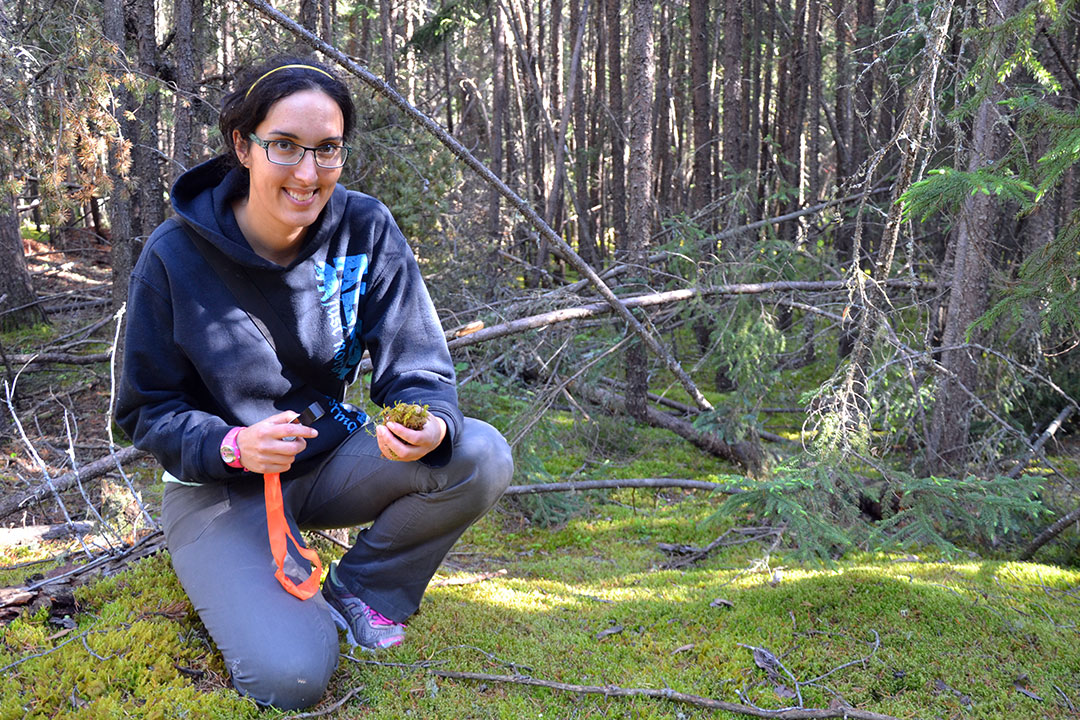
Student unfolds secrets of boreal forest moss
Growing up camping and hiking, Mélanie Jean loved nature but didn’t think much of the squishy green moss carpeting forests.
By Federica Giannelli"Now I know mosses have a whole secret world,” says Jean, a University of Saskatchewan biology PhD student. “It’s like discovering a mini forest in the forest.”
Not just pretty, mosses contribute up to 30 per cent of Canada’s boreal forest total growth every year, while maintaining the organic floor necessary for evergreens to grow.
Jean presented evidence at two major ecology conferences showing that a combination of fire and climate is changing where moss grows. Without mosses, some evergreen forests will not grow back, something scientists had not known until now.
“Only if we reduce climate change can we help keep forest life cycles as they were before,” she said.
Fewer evergreens in the boreal forest, which covers almost 90 per cent of Canada’s forested areas, would significantly impact the timber and tourism industries. It would also severely affect northern communities’ hunting and traditional land uses, and threaten wildlife such as caribou and songbirds.
“Large-scale changes in the boreal forest will have global implications for the pace of climate change and how we can adapt to it,” said biology professor Jill Johnstone, Jean’s supervisor. “This is of great policy importance during this century of rapid environmental change.”
Johnstone said severe fires worsened by climate change burn down deeper into the evergreen forest’s organic floor. With the mineral soil exposed below, evergreen plants can’t grow back as they usually do after fires and are eventually replaced by broadleaf trees such as birch and aspen.
“I found that mosses, too, grow back in this new forest but only for about 20 years after fires,” said Jean. “After that, they struggle to survive because of fallen tree leaves that slowly kill the moss.”
She found that fallen leaves block the sunlight, crush mosses, and leak chemicals normally present in trees that are detrimental to these plants. She said moss thrives in evergreen forests precisely because these trees produce small needles instead of large leaves.
Mosses also insulate the boreal forest’s permafrost soil, making the forest a good carbon sink. The forest stores more carbon than it releases in the soil, which helps combat greenhouse emissions. Without mosses, the permafrost would melt and release the carbon captured, hastening climate change.
By combining field experiments and ecological modelling, Jean and Johnstone have studied forests of different types in a long-term research site in Alaska. She did her work in Alaska because, unlike Canada, there are more roads available to reach remote areas.
“All my results apply to the Canadian boreal forest too,” said Jean.
Her project has been funded by the federal agency NSERC, the U.S. government, and the U.S. National Science Foundation.
“Mélanie’s work has substantially advanced our understanding of how boreal ecosystems work,” said Johnstone. “There are only two or three labs worldwide that are doing this type of research.”
Federica Giannelli is a graduate student intern in the U of S research profile and impact unit.
This article first ran as part of the 2017 Young Innovators series, an initiative of the U of S Research Profile and Impact office in partnership with the Saskatoon StarPhoenix.

